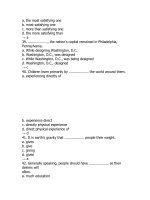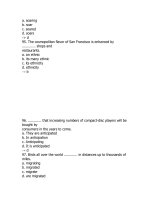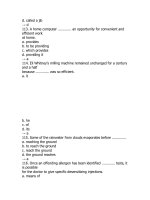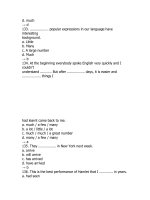câu hỏi trắc nghiệm môn tiếng anh
Bạn đang xem bản rút gọn của tài liệu. Xem và tải ngay bản đầy đủ của tài liệu tại đây (103.03 KB, 64 trang )
. Circle the letter that best matches with the underlined word(s)
1. Automobile is a self-propelled vehicle used primarily on public roads.
a. Vehicle uses man-power to work.
b. Vehicle uses horse-power to work.
c. Vehicle uses fuel/electrical-power to work.
d. All correct.
2. Automobile is a self-propelled vehicle used primarily on public roads.
a. Originally
b. In the first time.
c. All correct.
d. All incorrect.
3. From the growth of suburbs to the development of elaborate road and highway systems.
a. complicated
b. complex
c. sophisticated
d. all correct.
4. From the growth of suburbs to the development of elaborate road and highway systems.
a. A big city/town
b. A trade place
c. An industrial zone.
d. An outlying part of a city or town
5. The so-called horseless carriage has forever altered the modern landscape.
a. Ship.
b. Train.
c. Automobile.
d. All incorrect.
6. The manufacture, sale, and servicing of automobiles have become key elements of industrial
economies.
a. main
b. major
c. coupling
d. a&b.
7. Cars will no doubt continue to shape our culture and economy well into the 21st century.
a. suspect
b. vacillation.
c. waver
d. all correct.
8. The engine produces mechanical power that is transmitted to the automobile’s wheels through a
drivetrain.
a. transmission & driveshaft(s).
b. differential & axles.
c. All correct.
d. All incorrect.
9. Suspension systems cushion the ride and help protect the vehicle.
a. springs system
b. shock absorbers system.
c. hanging system
d. All correct.
10. Suspension systems cushion the ride and help protect the vehicle by bumps, heavy loads, and other
stresses.
Page 1 of 22
a. strike.
b. thump
c. accident.
d. a&b
II. Gap filling
1. Automobiles are classified by __________
a. size, style
b. number of doors.
c. intended use.
d. all correct.
2. The typical automobile has four wheels and can carry up to six people is called __________
a. car / auto
b. motorcar / truck
c. motorcar / passenger car.
d. a&c.
3. Larger vehicles designed to carry more passengers are called __________
a. vans/minivans.
b. omnibuses/buses
c. doubledeck bus
d. all correct.
4. Minivans are van-style vehicles built on a __________ car frame
a. passenger
b. truck
c. bus
d. omnibus
5. Minivans can usually carry up to __________ passengers
a. 5
b. 6
c. 7
d. 8
6. SUVs is a __________
a. Same-utility vehicles
b. Sport-universal vehicles
c. Sport-utility vehicles
d. Sport-utility vendor.
7. SUVs are __________ than passenger cars.
a. more rugged
b. more difficult
c. weaker.
d. softer.
8. The automobile is built __________ an engine.
a. before
b. behind
c. between
d. around.
9. The engine produces mechanical power that is transmitted to the automobile’s wheels through a
__________
a. suspension system
b. wheel system.
c. drivetrain system.
d. all correct.
10. __________systems provide control over direction and speed.
a. Drivetrain
b. Steering and braking.
c. Wheel system.
Page 2 of 22
d. Suspension system.
III. True/false
1. Automobiles can be use primarily on public roads. ( True False)
2. Servicing of automobiles has become key elements of industrial economies.( True False)
3. Automobile industries create only mobilities and jobs. ( True False)
The 21st century can be called the Age of the Automobile. ( True False)
4.
5. Vans are designed to carry people. ( True False)
6. Minivans can carry more than 9 people. ( True False)
7. Sport-utility vehicles are more rugged than passenger cars. ( True False)
8. Sport-utility vehicle can be drived in mud or snow. ( True False)
9. The engine produces mechanical power. ( True False)
10. Drivetrain consist of a transmission, one or more driveshafts, a differential gear, and axles . ( True
False)
11. Suspension systems includes springs and shock absorbers and cushion. ( True False)
12. Wheels and tires are rotated by powered axles. ( True False)
13. Steering and braking systems provide control over direction and speed. ( True False)
14. Electrical system only starts and operates the engine. ( True False)
15. Bumpers, air bags, and seat belts are safety features of automobile. ( True False)
UNIT 2
I. Circle the letter that best matches with the underlined word(s)
1. The engine is the heart of a car although it is normally hidden under the bonnet.
a. body of car
b. the metal cover or shield over the motor.
c. spring
d. all correct.
2. The intake stroke draws air and fuel into the combustion chamber
a. induction stroke.
b. income stroke.
c. introduction stroke
d. all correct.
3. The piston descends in the cylinder bore to evacuate the combustion chamber.
a. place where fuel is ignited.
b. place where air/fuel mixture is compressed.
c. the volume of cylindrical bore.
d. a & b
4. In the two-stroke engine, the space in the crankcase works as a pre-compression chamber for each
successive fuel charge.
a. main compression chamber.
b. sub compression chamber.
c. dual compression chamber.
d. all correct.
5. The fuel and lubricating oil are premixed and introduced into the crankcase
a. connecting rod
b. manifold
c. the housing for a crankshaft and connecting parts in engine
d. carburettor.
6. In a two-stroke engine, cleaning of the exhaust gas by a catalytic converter is difficult.
a. An antipollution device.
b. It uses a catalyst to chemically convert pollutants in the exhaust gases.
c. It converts pollutants into harmless compounds.
d. All correct.
7. The intake stroke on the diesel engine draws only air into the cylinder.
a. ignites.
Page 3 of 22
b. compresses
c. intakes
d. exhausts.
8. At near maximum compression, finely atomized diesel fuel is sprayed into the hot air.
a. very tiny drop of fuel.
b. large drops of fuel.
c. very fine drop of fuel.
d. a & c
9. In the petrol engines, too high a temperature in the combustion chamber ignites the petrol
spontaneously.
a. happening automatically.
b. happening fully
c. happening carefully
d. all correct.
10. This unwanted phenomenon is often referred to as ‘knocking’
a. An appearance
b. anything visible
c. a & b correct
d. a & b incorrect.
11. Most automobile engines are:
a. large and heavy
b. gasoline-fueled, spark-ignited, liquid-cooled, internal combustion type
c. unable to run at elevations that are below sea level
d. able to operate with any fuel other than gasoline.
12. An exhaust valve is:
a. a hole in the cylinder head
b. a mechanism for releasing the combustion products from the cylinder
c. the pipe connecting the engine to the muffler
d. a small opening at the bottom of a piston.
13. Power is produced during:
a. intake stroke
b. compression stroke
c. combustion stroke
d. exhaust stroke.
14. The air–fuel ratio is:
a. the rate at which combustible products enter the engine
b. the ratio of the mass of air to the mass of fuel in a cylinder before ignition
c. the ratio of gasoline to air in the exhaust pipe
d. intake air and fuel velocity ratio.
15. An SI engine is:
a. a type of internal combustion engine
b. a Stirling engine
c. always fuel injected
d. none of the above.
II. Gap filling
1. The _____ is also referred to as the Otto cycle engine.
a. two-stroke engine.
b. four-stroke engine
c. rotary engine.
d. Wankel engine.
2. The intake stroke _____ air and fuel into the combustion chamber.
a. intakes
b. draws
c. introduces
d. all correct.
3. The piston _____ in the cylinder bore to evacuate the combustion chamber.
Page 4 of 22
a. moves downward
b. descends
c. passes from a higher to a lower place.
d. all correct.
4. A petrol engine, whether four- or two-stroke, is called a _____
a. Electriacal Ignition engine
b. Compressed Ignition engine
c. Spark Ignition engine.
d. all correct
5. The four-stroke-cycle engine contains the lubricating oil in the crankcase . This lubricant _____
a. lubricates crankshaft bearings.
b. cools the hot piston
c. a&b correct.
d. a&b incorrect.
6. The two-stroke engine is similar to that of the four-stroke-cycle engine in _____.
a. its fuel.
b. its reciprocating mechanism.
c. its design.
d. its usage.
7. The two-stroke engine does not use _____.
a. spark plug.
b. inlet and exhaust valves.
c. crankshaft
d. piston.
10. In two-stroke engine, the upward and downward motion of the piston simultaneously opens and
closes
these _____.
a. port-holes
b. cylinder head.
c. cylinder block.
d. all correct.
11. The intake stroke on the diesel engine draws only _____ into the cylinder.
a. air/fuel mixture
b. oil
c. air
d. water.
12. Since diesel engines do not use a _____ .
a. filter
b. spark plug.
c. injector.
d. high pressure pump.
13. There are two methods by which fuel is injected into a combustion chamber, they are _____.
a. blowing & intaking
b. compressing & exhausting
c. direct or indirect injection.
d. all correct.
14. Advantages of reciprocating engines:
a. high compression ratio and high heat efficiency.
b. low friction and high durability.
c. noise and vibration.
d. a&b
15. Disadvantages of reciprocating engines:
a. high compression ratio and high heat efficiency.
b. noise and vibration.
c. difficult to reuse the exhaust heat.
d. b&c
Page 5 of 22
III. True/false
1. We can see the detailed mechanisms of a engine in a car ( True False)
2. The four-stroke engine is also referred to as the Otto cycle engine when petrol is used as fuel ( True
False)
3. In four-stroke petrol engine, only air is intaken in induction stroke ( True False)
4. Two-stroke engine uses inlet and exhaust valves ( True False)
5. The name diesel comes from the inventor of the diesel engine, R. Diesel ( True False)
6. The intake stroke on the diesel engine draws air/diesel mixture into the cylinder ( True False)
7. A diesel engine uses a spark plug for ignition. ( True False)
8. A petrol engine normally needs a throttle valve to control airflow into the cylinder and a diesel
engine does ( True False)
9. In DI engine, the fuel is injected directly into the cylinder ( True False)
10. In IDI engine, the fuel is injected and initial combustion takes place in a small pre -ombustion
chamber formed in the cylinder head ( True False).
UNIT 3
I. Circle the letter that best matches with the underlined word(s)
1. A progressive engagement clutch is interposed between the engine and the gearbox.
a. placed
b. located
d. put
d. all correct
2. Two plates E and F are keyed on the ends of shafts A and B
a. located
b. interposed
c. locked
d. put
3. These problems are obviated when diaphragm-type springs are used.
a. anticipated
b. prevented
c. a&b correct
d. a&b incorrect
4. The transmission is a gear system that adjusts the ratio of engine speed to wheel speed.
a. rocker
b. piston rod
c. gearbox
d. pin
5. The transmission enables the engine to operate within its optimal performance range
a. Best possible
b. most important
c. best wishes
d. all correct.
6. The shaft and gears in this shaft are called the layshaft.
a. input shaft.
b. output shaft
c. driveshaft.
d. intermediate shaft in gearbox.
7. Dog teeth fit into holes on the sides of the gears to engage them.
a. teeth on the gear.
b. teeth on the dog.
c. teeth on the collar.
d. teeth on the mount.
Page 6 of 22
8. Manual transmissions in modern passenger cars use synchronizers to eliminate the need for double-
clutching.
a. A device allows the collar and the gear to make frictional contact.
b. A device allows the dogteeth and the gear to make frictional contact.
c. A device lets the collar and the gear synchronize their speeds.
d. a&c correct.
9. Every manufacturer implements transmissions and synchros in different ways
a. design & manufacturing
b. design & fabricating
c. design & producing
d. all correct.
10. Universal joints allow the rear axle housing and wheels to move up and down while the transmission
remains stationary.
a. Rigid coupling
b. Flexible couplings
c. One-way coupling
d. all correct
11. Joints known as constant velocity joints are
a. rigid coupling
b. coupling is used in front wheel drive automobiles.
c. disconnect the driveshaft to the transmission.
d. all correct.
12. The most obvious is the right angle transfer of the rotary motion of the drive shaft to the wheels.
a. parallel
b. oneway
c. perpendicular
d. all correct
II. GAP FILLING
1. A clutch is a releasable coupling connecting the _____ ends of two coaxial shafts.
a. top
b. bottom
c. adjacent
d. all correct
2. Mechanical clutches fall into two main categories: _____
a. positive disengagement and progressive disengagement.
b. positive terminal and negative terminal.
c. positive engagement and progressive engagement.
d. Positive displacement and negative displacement.
3. A progressive engagement clutch is the _____
a. friction type
b. magnetic type
c. electronic type
d. hydraulic type
4. At high rotational speeds, problems can arise with multi-spring clutches is _____
a. inertial force
b. magnetic force
c. gravity
d. centrifugal force
5. These problems are _____when diaphragm-type springs are used
a. added
b. anticipated
c. a&b correct
d. obviated
6. _____ provides a gear ratio between the engine speed and vehicle speed.
Page 7 of 22
a. gearbox
b. clutch & u-joint
c. differential
d. all correct
7. Manual transmissions in modern passenger cars use _____ to eliminate the need for double-
clutching.
a. synchronizers
b. spline
c. key
d. all correct
8. The drive shaft is used to _____ the transmission output shaft to the differential input shaft.
a. couple
b. connect
c. link
d. all correct
9. The gear ratio also _____ fuel economy.
a. effects
b. affects
c. influence
d. all correct
10. When the vehicle is turning a corner, the “outside” wheel must turn _____ than the “inside’’ wheel.
a. slower than
b. less than
c. faster than
d. same as
III. TRUE/FALSE
1. Engine, clutch, transmission, drive shaft, differential and driven wheels are elements of
drivetrain system. ( True False)
2. A clutch is a releasable coupling. ( True False)
3. There are two main categories of mechanical clutches. ( True False)
4. Progressive engagement clutch is friction type. ( True False)
5. Centrifugal force is the main problem which arises with multi-spring clutches. ( True False)
6. Diaphragm-type springs obviate the problems in the multi-spring clutches at high rotational
speeds. ( True False)
7. The transmission enables the engine to operate within its optimal performance range. ( True
False)
8. By providing a gear ratio between the engine speed and vehicle speed of the clutch, engine
provides adequate power to drive the vehicle at any speed. ( True False)
9. Layshaft is a intermidiate shaft in gear box. ( True False)
10. Synchronizers add the need for double-clutching in cars. ( True False)
11. Transmissions and synchros are implemented in the same way by all auto manufacturer. (
True False)
12. The drive shaft is used to couple the transmission output shaft to the differential input shaft. (
True False)
13. Universal joints a rigid couplings. ( True False)
14. Differential allows each driven wheel to turn at a different speed. ( True False)
15. Differential is the torque decrease provided by the gear ratio. ( True False)
UNIT 4
I. CIRCLE THE LETTER
1. Another major automotive sub-system is the suspension system.
a. useful
b. important
Page 8 of 22
c. a&b correct
d. key
2. The primary purpose of the suspension system is to isolate the car body from the vertical motion of
the
wheels as they travel
e. separate
f. incorporate
g. conduct
h. b&c correct
3. The weight of the car is supported by springs.
a. a season of a year
b. a part of suspension system
c. an elastic device
d. b&c correct
4. Spring is, in essence, a heavy-duty torsion bar coiled around an axis.
a. high load
b. high capacity
c. high performance
d. all correct
5. Shock absorber which is in effect a viscous damping device.
a. strut
b. snubber
c. a part of suspension system
d. all correct
6. The upper mount of the shock connects to the frame
a. unsprung weight









